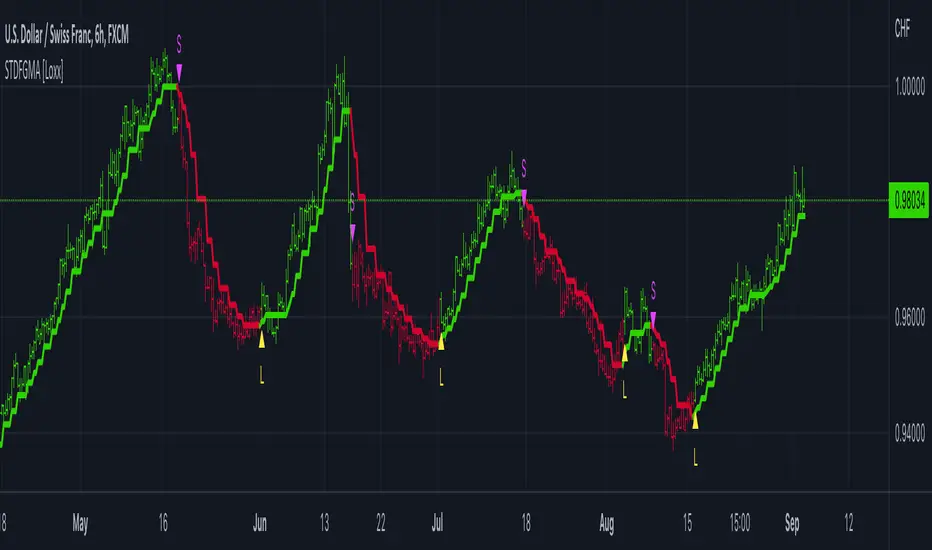OPEN-SOURCE SCRIPT
Mis à jour STD-Filtered, Gaussian Moving Average (GMA) [Loxx]

STD-Filtered, Gaussian Moving Average (GMA) [Loxx] is a 1-4 pole Ehlers Gaussian Filter with standard deviation filtering. This indicator should perform similar to Ehlers Fisher Transform.
The purpose of the standard deviation filter is to filter out noise by and by default it will filter 1 standard deviation. Adjust this number and the filter selections (price, both, GMA, none) to reduce the signal noise.
What is Ehlers Gaussian filter?
This filter can be used for smoothing. It rejects high frequencies (fast movements) better than an EMA and has lower lag. published by John F. Ehlers in "Rocket Science For Traders". First implemented in Wealth-Lab by Dr René Koch.
A Gaussian filter is one whose transfer response is described by the familiar Gaussian bell-shaped curve. In the case of low-pass filters, only the upper half of the curve describes the filter. The use of gaussian filters is a move toward achieving the dual goal of reducing lag and reducing the lag of high-frequency components relative to the lag of lower-frequency components.
A gaussian filter with...
For an equivalent number of poles the lag of a Gaussian is about half the lag of a Butterworth filters: Lag = N * P / (2 * ¶2), where,
N is the number of poles, and
P is the critical period
Special initialization of filter stages ensures proper working in scans with as few bars as possible.
From Ehlers Book: "The first objective of using smoothers is to eliminate or reduce the undesired high-frequency components in the eprice data. Therefore these smoothers are called low-pass filters, and they all work by some form of averaging. Butterworth low-pass filtters can do this job, but nothing comes for free. A higher degree of filtering is necessarily accompanied by a larger amount of lag. We have come to see that is a fact of life."
References John F. Ehlers: "Rocket Science For Traders, Digital Signal Processing Applications", Chapter 15: "Infinite Impulse Response Filters"
Included
Related indicators
STD-Filtered, Gaussian-Kernel-Weighted Moving Average [Loxx]
![STD-Filtered, Gaussian-Kernel-Weighted Moving Average [Loxx]](https://s3.tradingview.com/4/4BKPUoCt_mid.png)
One-Sided Gaussian Filter w/ Channels [Loxx]
![One-Sided Gaussian Filter w/ Channels [Loxx]](https://s3.tradingview.com/l/LIGmsUQa_mid.png)
Fisher Transform w/ Dynamic Zones [Loxx]
![Fisher Transform w/ Dynamic Zones [Loxx]](https://s3.tradingview.com/d/dqkU04U2_mid.png)
R-sqrd Adapt. Fisher Transform w/ D. Zones & Divs. [Loxx]
![R-sqrd Adapt. Fisher Transform w/ D. Zones & Divs. [Loxx]](https://s3.tradingview.com/k/k4fpHEih_mid.png)
The purpose of the standard deviation filter is to filter out noise by and by default it will filter 1 standard deviation. Adjust this number and the filter selections (price, both, GMA, none) to reduce the signal noise.
What is Ehlers Gaussian filter?
This filter can be used for smoothing. It rejects high frequencies (fast movements) better than an EMA and has lower lag. published by John F. Ehlers in "Rocket Science For Traders". First implemented in Wealth-Lab by Dr René Koch.
A Gaussian filter is one whose transfer response is described by the familiar Gaussian bell-shaped curve. In the case of low-pass filters, only the upper half of the curve describes the filter. The use of gaussian filters is a move toward achieving the dual goal of reducing lag and reducing the lag of high-frequency components relative to the lag of lower-frequency components.
A gaussian filter with...
- one pole is equivalent to an EMA filter.
- two poles is equivalent to EMA(EMA())
- three poles is equivalent to EMA(EMA(EMA()))
- and so on...
For an equivalent number of poles the lag of a Gaussian is about half the lag of a Butterworth filters: Lag = N * P / (2 * ¶2), where,
N is the number of poles, and
P is the critical period
Special initialization of filter stages ensures proper working in scans with as few bars as possible.
From Ehlers Book: "The first objective of using smoothers is to eliminate or reduce the undesired high-frequency components in the eprice data. Therefore these smoothers are called low-pass filters, and they all work by some form of averaging. Butterworth low-pass filtters can do this job, but nothing comes for free. A higher degree of filtering is necessarily accompanied by a larger amount of lag. We have come to see that is a fact of life."
References John F. Ehlers: "Rocket Science For Traders, Digital Signal Processing Applications", Chapter 15: "Infinite Impulse Response Filters"
Included
- Loxx's Expanded Source Types
- Signals
- Alerts
- Bar coloring
Related indicators
STD-Filtered, Gaussian-Kernel-Weighted Moving Average [Loxx]
![STD-Filtered, Gaussian-Kernel-Weighted Moving Average [Loxx]](https://s3.tradingview.com/4/4BKPUoCt_mid.png)
One-Sided Gaussian Filter w/ Channels [Loxx]
![One-Sided Gaussian Filter w/ Channels [Loxx]](https://s3.tradingview.com/l/LIGmsUQa_mid.png)
Fisher Transform w/ Dynamic Zones [Loxx]
![Fisher Transform w/ Dynamic Zones [Loxx]](https://s3.tradingview.com/d/dqkU04U2_mid.png)
R-sqrd Adapt. Fisher Transform w/ D. Zones & Divs. [Loxx]
![R-sqrd Adapt. Fisher Transform w/ D. Zones & Divs. [Loxx]](https://s3.tradingview.com/k/k4fpHEih_mid.png)
Notes de version
Updated formulaNotes de version
Updated formulasScript open-source
Dans l'esprit TradingView, le créateur de ce script l'a rendu open source afin que les traders puissent examiner et vérifier ses fonctionnalités. Bravo à l'auteur! Bien que vous puissiez l'utiliser gratuitement, n'oubliez pas que la republication du code est soumise à nos Règles.
Public Telegram Group, t.me/algxtrading_public
VIP Membership Info: patreon.com/algxtrading/membership
VIP Membership Info: patreon.com/algxtrading/membership
Clause de non-responsabilité
Les informations et publications ne sont pas destinées à être, et ne constituent pas, des conseils ou recommandations financiers, d'investissement, de trading ou autres fournis ou approuvés par TradingView. Pour en savoir plus, consultez les Conditions d'utilisation.
Script open-source
Dans l'esprit TradingView, le créateur de ce script l'a rendu open source afin que les traders puissent examiner et vérifier ses fonctionnalités. Bravo à l'auteur! Bien que vous puissiez l'utiliser gratuitement, n'oubliez pas que la republication du code est soumise à nos Règles.
Public Telegram Group, t.me/algxtrading_public
VIP Membership Info: patreon.com/algxtrading/membership
VIP Membership Info: patreon.com/algxtrading/membership
Clause de non-responsabilité
Les informations et publications ne sont pas destinées à être, et ne constituent pas, des conseils ou recommandations financiers, d'investissement, de trading ou autres fournis ou approuvés par TradingView. Pour en savoir plus, consultez les Conditions d'utilisation.